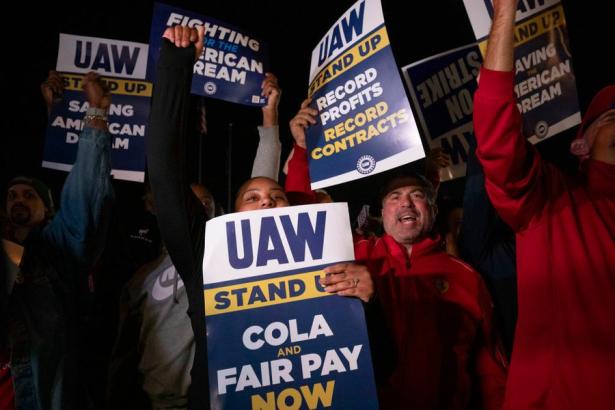The latest issue of In These Times is a special, extra-length issue devoted entirely to the subject of socialism in America today. This special issue is available now. Order your copy today.
Workers walked off their shifts on September 14 at midnight to cheering crowds as the United Auto Workers launched its first simultaneous strike against the “Big Three” automakers — Ford, General Motors and Stellantis. The initial work stoppages were not company-wide but instead targeted three locations: GM’s Wentzville Assembly in Missouri, Stellantis’ Toledo Assembly Complex in Ohio, and Ford’s Michigan Assembly Plant in Wayne, Mich., just outside Detroit. The plants employ some 12,700 of the roughly 150,000 UAW members who work for the Big Three.
The strike strategy, developed under the leadership of reform challenger Shawn Fain, was defined by its element of surprise. The union did not publicly reveal the strike targets until 10:00 p.m. on September 14, two hours before the contracts jointly expired. The UAW calls this approach a “stand-up strike,” which is “a new approach to striking. Instead of striking all plants all at once, select locals will be called on to ‘stand up’ and walk out on strike.”
If the companies refuse to make concessions and bargaining drags on, the strike may spread to other locals, the union says, but the companies will not be informed of these locations ahead of time. The intention is to keep the Big Three on their toes, never knowing where the strike will happen next and forced to make costly preparations at numerous locations.
In this case, the element of surprise appears to have worked, no small feat for a huge operation in which all 150,000 UAW members were prepared to strike.
“As far as I’m aware, we never got notification of where the union may or may not strike. We heard like everyone else at 10 p.m.,” Jodi Tinson, a corporate communications representative at Stellantis, told In These Times.
Ford did not respond to In These Times’ inquiry and GM had no comment.
Asked whether Stellantis prepared for strikes at locations that did not walk out, costing the company money, Tinson said, “It’s the nature of bargaining that there are rumors and speculation. … In a normal situation like this when a union calls a strike, it’s typically enterprise-wide. We were ready.”
“Strike preparation and contingency planning is part of our normal process in a contract negotiation year — as a responsible business we have to do that,” she added. “They made it very clear that a strike was possible and we did everything we needed to do to protect the business.”
Tinson’s admission that Stellantis did not know which plant would be struck represents a break from the more typical pattern of strikes where employers have a good idea of what to expect and are able to prepare accordingly.
“The strategy here is to maximize the hurt on the company and minimize the impact on strikers and the union more generally,” Barry Eidlin, professor of sociology at McGill University and an expert on labor and social movements, tells In These Times. “They want to preserve the strike fund and make sure workers aren’t enduring more hardship than is necessary, and a key to that is to keep the company guessing.”
“The fact that the company was kept guessing shows the strategy was working,” Eidlin says.
Earlier this week, Fain called the stand-up strike “our generation’s answer to the sit-down strike of the 1930s.” He specifically pointed to “the creativity, discipline and defiant spirit” of the Flint sit-down strike of 1936-1937, which resulted in the auto union winning recognition at the first of the Big Three — General Motors — and is widely considered a turning point in U.S. labor history.
Like the unfolding stand-up strike, the novelty of the sit-down tactic used in Flint threw the employer off balance.
The Flint strike began with workers occupying two of GM’s Fisher Body Plants, but it did not end there. At a critical moment over a month into the strike, the UAW escalated the work stoppage by spreading it to Chevrolet Plant Number 4, the company’s crucial motor assembly division.
To take over the plant, the union daringly created a diversion by letting it slip to company spies that they planned to occupy a different factory — Chevrolet Plant Number 9 — even convincing most of the workers that this was the target. GM’s hired thugs and the Flint police were ready, violently stopping the sit-down in Plant Number 9 before it could even begin. Meanwhile, a smaller group of workers took over the real target: the unguarded Plant Number 4.
Shortly after this successful maneuver, GM returned to the bargaining table and the strike ended in a historic victory for the UAW.
Room for escalation and the element of surprise were pivotal factors in the success of the Flint sit-down strike in 1937, and they may well prove to be the key to a UAW victory in the stand-up strike of 2023. As Fain put it about the ongoing stand-up strike, “This is a strike that keeps the companies guessing as to where and when the next local will walk out.”
This article is a joint publication of In These Times and Workday Magazine, a non-profit newsroom devoted to holding the powerful accountable through the perspective of workers.
--
Sarah Lazare is the editor of Workday Magazine and a contributing editor for In These Times. She tweets at @sarahlazare.
Jeff Schuhrke is a labor historian, educator, journalist and union activist who teaches at the Harry Van Arsdale Jr. School of Labor Studies, SUNY Empire State University in New York City. He has been an In These Times contributor since 2013. Follow him on Twitter @JeffSchuhrke.


Spread the word